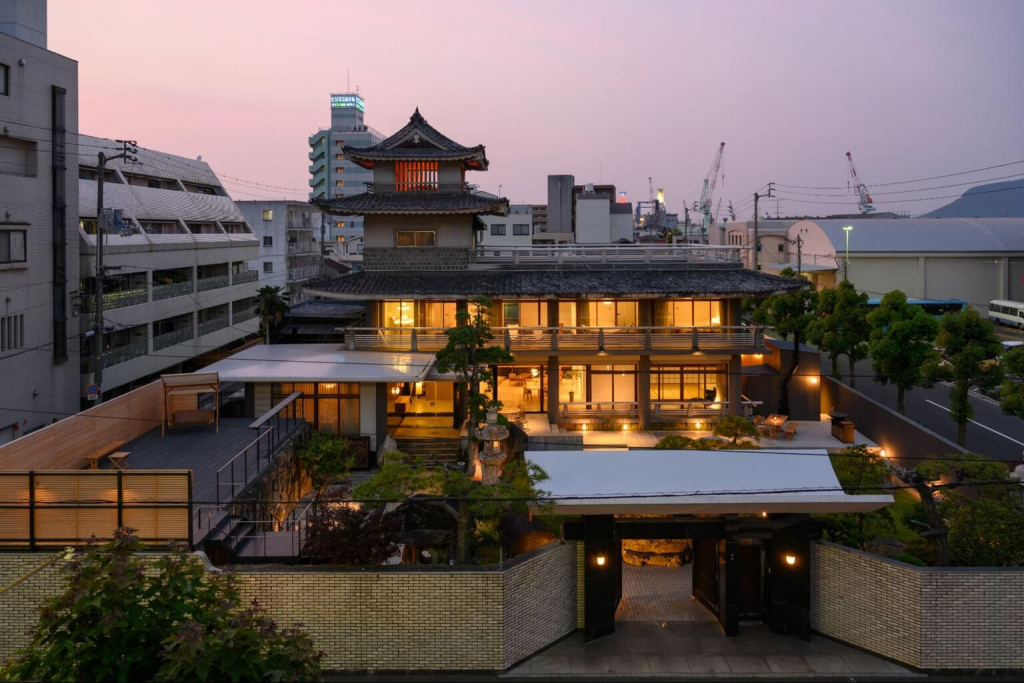One of Japan’s biggest ‘water castles’ – castles built by the sea and usually equipped with a dedicated entrance for ships – is Takamatsu Castle, which overlooks the city of Takamatsu in Kagawa Prefecture. In addition to an exciting history, Takamatsu is one of the country’s municipalities with a stand-out relationship with art and architecture.
Anabukitei, an 888-square-meter residence, is a testament to that. Groups of up to nine people can rent out the home, outbuildings and Japanese garden, which come equipped with everything you might need for a rejuvenating stay. The owner, who himself lived in the house, will be at your service from check-in to check-out.
Anabukitei has been working on refreshing existing rooms and adding new amenities, with a reopening date set to September 29, 2022. This is just in time for the wrap-up season of the Setouchi Triennale, the much-anticipated art festival that takes over the region.

Make Time to Relax
Anabukitei prides itself on providing an experience focused on relaxation. Inspired by the Scandinavian concept of hygge, often described as a feeling of coziness, the residence hopes its guests will travel here to decompress. It’s recommended to stay with close friends, long-time partners or family, and to spend your holiday deepening your relationships with your fellow roommates and yourself.
But how exactly can you do that?
Anabukitei incorporates three vital elements: adaptation to Setouchi’s passing of time, a comfortable interior and the introduction of facilities that encourage mindfulness.
Much like other island regions in the world, time simply flows slower in Takamatsu City. For centuries, the area has been famous for its soothing quality, which many credit to the sounds of flowing water. Be on the lookout for notable buildings designed by world-class architects and public art. Anabukitei also offers a special cruise package, allowing guests to sail the waves of the Seto Inland Sea aboard a luxurious catamaran and learn more about the culture of the surrounding islands at a leisurely pace.


Come home to a residence where rooms are decorated with European furniture with maximum cozy factor. In every corner of Anabukitei, you can see and feel the craftsmanship, not only in the decorative piece but in the structure of the building itself. This is especially true for the Japanese-style rooms, where the skill of the owner’s grandfather, who built this house with his own hands in the hopes of making it a place of rest and love, is apparent no matter where you lay your eyes.
New amenities further provide guests with plenty of options to lounge, all located in the new spa on the premises. Sweat it out in the Finnish sauna or soak in the outdoor bath before (or after) taking an afternoon nap in the outdoor rest area.
Start and end your day with delicious dishes prepared at the residence by skilled local chefs, who will kindly introduce you to the seasonal ingredients they use to make your meal. Guests can indulge alongside a view of the sunlit garden in the morning or illuminated at night.

Inspired by Kagawa
Anabukitei’s defining characteristics are a showcase of Kagawa Prefecture’s culture and history. The residence comes with its own private Japanese garden, where you’ll find one tree with a very special significance: a black pine tree over 100 years old. This type of tree has a tendency to grow upward but was shaped in an unusual way thanks to a skilled gardener.
Pine trees actually have a special place in the residents’ hearts here in Takamatsu. Heading to Ritsurin Garden, originally built in the 18th century for local feudal lords, is a must for those interested in Japanese gardens or landscaping. With the maintenance of 1,400-plus pines, gardeners in Takamatsu have developed a unique set of skills for caring carefully for the tree.

Another unique feature of Anabukitei is its masonry work. Throughout the residence, you can see structures, including a wall and some decorative pieces in the garden and sauna, made of aji stone. One of the three great granites of Japan and native to Kagawa, aji stone, is nicknamed “the diamond of granite” because of its durability, often compared to that of quartz, and its density of particles, which give it a beautiful and luxurious appearance.
Anabukitei is located in the same neighborhood as the Isamu Noguchi Garden Museum, a cultural facility dedicated entirely to the great Japanese sculptor. The museum was designed, as per Noguchi’s wishes, to inspire. It’s because of Noguchi’s work that the aji stone grew in popularity abroad, and the artist’s quest for constant inspiration is why it was important to incorporate the material into the design and decoration of Anabukitei.
Need more convincing? Check out Anabukitei’s Instagram page to see what they have to offer. To book your stay, visit Anabukitei’s official website.
Sponsored Post








